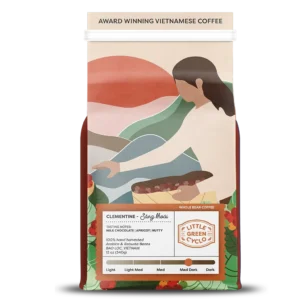
The two most common types of coffee people enjoy daily are Arabica Coffee (Coffea arabica) and Robusta Coffee (Coffea Canephora). Majority of the Arabica species of coffee are cultivated mostly in Latin America. Arabica is generally sweeter and has a variety of different flavors that occur naturally. Some beans may taste more nutty or fruity while others may have hints of chocolate. Robusta species of coffee are mostly cultivated in Africa. Robusta is more earthy tasting and often has a stronger coffee taste, it is also higher in caffeine and is usually used when making espresso.
The coffee plant is a small tropical evergreen shrub that can grow up to fifteen feet tall if not trimmed and maintained. It has a woody stem and long broad glossy green leaves and small white flowers when in bloom. The fruit of the coffee plant is referred to as a cherry and varies from a bright red to a darker purple color when ripe. The cherry has two seeds in the pulp of the fruit. The pulp is removed, and the seed is then dried out. The dried-out seed is then referred to as a coffee bean.
When it is time to plant new coffee bushes the coffee seeds are planted in the wet season so that they will take root better in the soil and have a higher chance of survival. The plant must grow three to four years before it matures enough to produce the fruit (cherry) of the coffee plant. The average life span of a coffee plant is estimated at 20 years if maintained. After that time the plant is removed, and the process starts over again.
Coffee requires a special type of tropical climate to grow. The proper elevation, temperature and right amount of water is a necessity no matter where it is planted. Coffee can be found in different continents along the equator between the Tropic of Capricorn and the Tropic of Cancer. This area is commonly known as the Coffee Belt, Coffee Bean Belt or the Bean Belt. There are many countries within the coffee belt known for their delicious coffee including Costa Rica, Columbia, Brazil, India, Asia, Indonesia, Yemen, Ethiopia and Kenya.
Coffee plants need to be planted at an elevation at 2,500 ft. or higher and require the perfect combination of temperatures between 40°F – 80°F and require rain fall on average of 60 – 80 inches per year for the plant to be healthy and productive. Coffee planted at an elevation of 3,000 ft or higher produces a sweet, harder bean that is considered by some to be better quality. Arabica coffee grows in higher elevations than Robusta.
Coffee grown at lower elevations does not have the same characteristic or qualities of coffee grown above 2,500 ft. But as always there are exceptions to that rule. Hawaiian coffee grows in elevations between 700 ft – 2,000 ft. The soil, temperature, rainfall and climate in Hawaii allows them to produce some of the best arabica coffee in the world.
At one time it was believed that coffee could only be grown in shade at high elevations, but over time it has been found that it can be grown in the sun at varying elevations and many other places. It’s amazing how much patience and time it takes for our coffee to grow.
About Blog Post Author
Maker's Coffee
Blog Writer
Maker’s Coffee blog writers consist of highly experienced and talented professionals dedicated to producing quality content that is interesting and informative regarding all things coffee.
Leave us a Comment
Specialty Coffee Marketplace
Shop for fresh roasted Specialty Coffee delivered direct from our award winning roasters.
-

Colombian El Jardin Natural
$20.95 — or subscribe and save 10% -

Ethiopia Durato Bombe
$24.00 — or subscribe and save 10% -

Costa Rica Las Lajas Red Honey
$17.95 — or subscribe and save 10% -

Durango Western Blend
$14.95 — or subscribe and save 10% -

Durango Espresso Blend
$15.20 — or subscribe and save 10% -

Clementine Blend – sảng khoái
$17.50 — or subscribe and save 10% -

Colombia Water Processed Decaf
$17.00 — or subscribe and save 10% -

Citizen Blend Washed Process
$18.50 — or subscribe and save 10% -

House of Per’La Maison Couture Blend
$17.00 — or subscribe and save 10% -

Dark Roast Blend
$17.00 — or subscribe and save 10%
















0 Comments